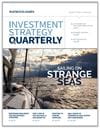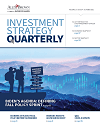Markets sailing into unknown seas
- 10.02.23
- Markets & Investing
- Article
CIO Larry Adam and his team share their outlook as the economy and financial markets chart their course for the remainder of this year and 2024.
To read the full article, see the Investment Strategy Quarterly publication linked below.
Investors had gotten used to smooth sailing with the economy remaining resilient, the equity market soaring double digits, and volatility remaining (mostly) subdued. But as we extend our voyage into unknown seas, we will need to maintain a steady hand on the tiller, recalling the old sailing motto that “The good seaman weathers the storm he cannot avoid, and avoids the storm he cannot weather.” So come sail away with me as we use eclectic sailing references to outline our views for the economy and financial markets to chart their course for the remainder of this year and 2024.
While Federal Reserve (Fed) Chairman Powell is not officially a sailor, he is the proverbial captain of the U.S. economy as the Fed’s actions have a major impact on its direction. And given the unprecedented way this economy has reacted to COVID, the Fed’s traditional GPS readings have been less reliable. Ironically, Powell sounded like an old salt himself when he recently said the Fed is “navigating by the stars under cloudy skies.” To his point, consumer spending has been robust, especially during the summer as consumers spent like drunken sailors on travel and leisure. But just like you don’t sail a boat backwards, you can’t determine the direction of the economy by looking behind you. And from our vantage point, a consumer spending fog is rolling in as job growth slows (turning negative in 2024), excess savings disappear, and borrowing becomes more costly. While government spending on infrastructure has helped buoy the economy, it will likely not be enough to offset the decline in consumer spending. As a result, we estimate the U.S. economy will have a mild recession in the first part of 2024 before rebounding in the second half. As a result, 2024 GDP will notch a small 0.4% growth rate — so not a disaster.
Given this economic outlook, we expect the Fed is nearing the end of its tightening cycle, with possibly one last interest rate hike this year. Its goal of submerging inflationary pressures is on course and will gain momentum reinforced by lower shelter costs as we progress through 2024. The headwind of challenging growth amid decelerating inflation should allow the Fed to begin cutting interest rates around mid year next year. What could cause a broken mast and shipwreck the economy? The Fed crying out like the famous commander David Farragut to “Damn the torpedoes! Full speed ahead!” If the Fed is overzealous lifting interest rates higher than we forecast or if they do not proactively cut rates to put a breeze into the sails when needed, it could cause a deeper recession. Oil prices surging sustainably above $100/barrel and dampening consumer confidence and spending power is also a risk on our radar. Fortunately, neither of these more severe scenarios are on our expected route.
For the fixed income market, the famed merchant and occasional sea traveler Marco Polo comes to mind. Legend has it that, while traveling to China, he got separated from his family. When they called for him as ‘Marco!,’ he reportedly responded ‘Polo!’—just like in the pool-based game. Like his family (and the closed-eyed player in the game), we keep searching and ‘calling out’ for lower interest rates. But like the open-eyed players, they remain elusive—and at elevated levels. However, we’re still sailing steadily toward a prediction that the 10-year Treasury yield will ‘tag’ 3.5% over the next 12 months. Persistent recessionary concerns, falling inflation, and record shorting of the bond market should support interest rates moving lower. We’re focused on the pool of Treasurys, high quality corporate bonds and municipals. Swimming in both the short end (shorter maturities) and deep end (longer maturities) of the pool remains of value. But over the next six to nine months, investors should transition to the deeper part of the pool. The fish out of water that we remain cautious on are higher risk, high yield bonds that do not hold a favorable risk/reward profile at current levels.
For the equity market, we turn to a hero of our youth, Popeye the Sailor. For those too young to remember, Popeye appeared weak… until transformed by his secret strengthener: a can of spinach. Typically, market performance is driven by the ‘spinach’ of earn ings growth, but, paradoxically, equities’ almost 13% return this year has been driven by price/multiple expansion, which is a measure of sentiment, not underlying fundamentals. In fact, 2023 earnings growth for the S&P 500 is a puny 2%. To strengthen the current market rally, companies will have to ‘eat their canned spinach’—that is, grow earnings. But a good can of earnings growth might be hard to find. Next year’s challenging economy will make top line sales growth difficult and will force companies to manage their expenses to maintain their margins. We do not expect corporate earnings to slip precipitously, but rather tread water around the $220 level in 2024, supporting our more subdued 12-month S&P 500 target of 4,650. A healthy appetite for spinach will likely not be until 2025.
One important characteristic of Popeye was his loyalty, especially to his wife, Olive Oyl, and his adopted son, Swee’Pea. Similarly, we remain committed to our equity and international preferences from the previous quarter. Within the U.S. equity market, we favor the Technology, Health Care, Financials and Energy sectors. These sectors continue to offer the best visibility into earnings even if we have a mild recession next year. While slowing economic activity will likely act as an anchor for small-capitalization stocks in the near term, small caps should be ready to set sail at some point in the first half of next year as economic activity bottoms and then subsequently improves.
Internationally, we still prefer the U.S. because of the macro back- drop—a more resilient and dynamic U.S. economy should limit the downside to economic growth and lead to a faster recovery. In addition, U.S. companies tend to be more technologically advanced and have greater profitability/efficiency which should help to navigate in the upcoming choppier environment. How- ever, there are several opportunities on the global landscape that are still worth exploring. For centuries, finding the shortest route to India was every sailor’s dream. Portuguese explorer Vasco de Gama, the first European to sail around the Cape of Good Hope to India, realized the dream, establishing valuable trade relations. Now instead of spices, India offers opportunities in technology and ‘friendshoring’ especially with the shift away from China and should benefit from favorable demographics. Select areas of Latin America (e.g., Mexico and Brazil) should benefit from elevated commodity prices and their respective central banks easing monetary policy.
When it comes to investing, it takes skill to navigate the tension between going faster versus making a wrong-footed move and running aground. In uncertain times, don’t try to learn the ropes on your own—we all need a crew! Your financial advisor can pro- vide the compass to guide you through investing challenges. Finally, we want to remember one of the most fun sailors of all time, Jimmy Buffett. Here’s a “Parrothead” wish from us to you: may you reach your financial goals early so you can enjoy that “It’s 5 O’Clock Somewhere,” eat a “Cheeseburger in Paradise,” and spend vacations in “Margaritaville”!

Read the full
Investment Strategy Quarterly
All expressions of opinion reflect the judgment of the Chief Investment Office, and are subject to change. This information should not be construed as a recommendation. The foregoing content is subject to change at any time without notice. Content provided herein is for informational purposes only. There is no guarantee that these statements, opinions or forecasts provided herein will prove to be correct. Past performance may not be indicative of future results. Asset allocation and diversification do not guarantee a profit nor protect against loss. The S&P 500 is an unmanaged index of 500 widely held stocks that is generally considered representative of the U.S. stock market. Keep in mind that individuals cannot invest directly in any index, and index performance does not include transaction costs or other fees, which will affect actual investment performance. Individual investor’s results will vary. Investing in small cap stocks generally involves greater risks, and therefore, may not be appropriate for every investor. International investing involves special risks, including currency fluctuations, differing financial accounting standards, and possible political and economic volatility. Investing in emerging markets can be riskier than investing in well-established foreign markets. Investing in the energy sector involves special risks, including the potential adverse effects of state and federal regulation and may not be suitable for all investors. There is an inverse relationship between interest rate movements and fixed income prices. Generally, when interest rates rise, fixed income prices fall and when interest rates fall, fixed income prices rise. If bonds are sold prior to maturity, the proceeds may be more or less than original cost. A credit rating of a security is not a recommendation to buy, sell or hold securities and may be subject to review, revisions, suspension, reduction or withdrawal at any time by the assigning rating agency. Investing in REITs can be subject to declines in the value of real estate. Economic conditions, property taxes, tax laws and interest rates all present potential risks to real estate investments. The companies engaged in business related to a specific sector are subject to fierce competition and their products and services may be subject to rapid obsolescence.



